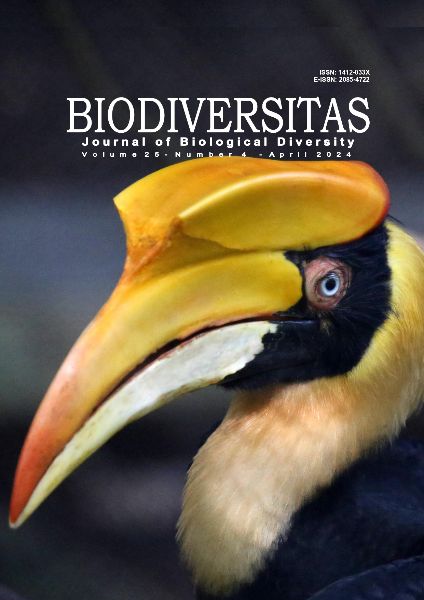Distribution of banana Fusarium wilt in Banyumas, Indonesia, and characterization of F. oxysporum isolates from infected bananas and taro growing on the same farm
##plugins.themes.bootstrap3.article.main##
Abstract
Abstract. Rahayuniati RF, Kurniawan REK, Mugiastuti E. 2024. Distribution of banana Fusarium wilt in Banyumas, Indonesia, and characterization of F. oxysporum isolates from infected bananas and taro growing on the same farm. Biodiversitas 25: 1344-1351. Fusarium wilt disease is a major constraint to banana production in Indonesia. The disease has also affected banana production in Banyumas, one banana-producing region. However, information on the distribution and characteristics of Fusarium wilt in Banyumas is limited. Growing mixed bananas and taro on the same farm in Banyumas is common. During the banana wilt survey, we found that taro also showed a symptom of Fusarium wilt. Therefore, this study aims to determine the distribution of Fusarium wilt disease on bananas in Banyumas, determine the characteristics of F. oxysporum on bananas and taro that grow on the same farm, and conduct pathogenicity tests of taro Fusarium isolates on bananas. The study consists of two steps, i.e., survey and sampling using purposive sampling technique conducted at the banana-growing area in Baturraden, Rawalo, Wangon, Purwojati, Gumelar, Ajibarang, Kemranjen, and Somagede districts. The second step involved the identification, characterization, and pathogenicity test of Fusarium isolate banana compared to isolate taro. A complete randomized design was used in an experimental study. All samples with Fusarium wilt symptoms were identified morphologically as comprised of macroscopic, microscopic characters and volatile odor of isolates. The results indicated that Fusarium wilt was equally distributed in Banyumas District, with the disease incidence reaching 50%. F. oxysporum isolates, which cause Fusarium wilt of banana and taro in Banyumas District, have indicated the same characteristics as Foc, i.e., diverse colony morphology, dominated by white to purple colonies with a cottony, smooth, and dry surface. Colonies are circular, irregular, dispersed, and undispersed on the surface of the medium with a filamentous margin; the single-septate oval-shaped microconidium and typical straight to sickle-shaped macroconidium. There were no significant differences between F. oxysporum isolate banana and taro in terms of disease incubation period, disease intensity, and Area Under Disease Progress Curve (AUDPC). Generally, this study found that Fusarium wilt was equally distributed in the lowlands. The Fusarium in bananas was the same as the Fusarium on taro in the same area, and the Fusarium isolated from taro effectively infected the banana.
##plugins.themes.bootstrap3.article.details##
Most read articles by the same author(s)
- LOEKAS SOESANTO, ANNISA RAHMADDILA RIZKY HARTONO, ENDANG MUGIASTUTI, HERI WIDARTA, Seed-borne pathogenic fungi on some soybean varieties , Biodiversitas Journal of Biological Diversity: Vol. 21 No. 9 (2020)
- ENDANG MUGIASTUTI, SUPRAYOGI, NUR PRIHATININGSIH, LOEKAS SOESANTO , Short Communication: Isolation and characterization of the endophytic bacteria, and their potential as maize diseases control , Biodiversitas Journal of Biological Diversity: Vol. 21 No. 5 (2020)
- LOEKAS SOESANTO, BISIRIL FATIHAH, ABDUL MANAN, ENDANG MUGIASTUTI, NUR PRIHATININGSIH , Organic control of Bemisia tabaci Genn. on Capsicum annuum with entomopathogenic fungi raw secondary metabolites , Biodiversitas Journal of Biological Diversity: Vol. 21 No. 12 (2020)
- LOEKAS SOESANTO, ENDANG MUGIASTUTI, ABDUL MANAN, The use of alternative liquid media for propagation of pathogenic fungi and their effect on weeds , Biodiversitas Journal of Biological Diversity: Vol. 22 No. 2 (2021)
- LOEKAS SOESANTO, RISMA ARSI SUSANTI, ENDANG MUGIASTUTI, ABDUL MANAN, MURTI WISNU RAGIL SASTYAWAN, JOKO MARYANTO, Remediation of chlorpyrifos-contaminated soils by crude secondary metabolites of Trichoderma harzianum T213 and its effect on maize growth , Biodiversitas Journal of Biological Diversity: Vol. 23 No. 5 (2022)
- ENDANG MUGIASTUTI, ABDUL MANAN, LOEKAS SOESANTO, Biological control of maize downy mildew with the antagonistic bacterial consortium , Biodiversitas Journal of Biological Diversity: Vol. 24 No. 9 (2023)
- AGUS SUROTO, ENDANG MUGIASTUTI, TARJOKO, EKA OKTAVIANI, MUHAMMAD BAHRUDIN, Diversity of insect carried-fungi in chili (Capsicum annuum) crop at Banyumas District, Central Java Province, Indonesia , Biodiversitas Journal of Biological Diversity: Vol. 24 No. 6 (2023)
- NUR PRIHATININGSIH, RUTH FETI RAHAYUNIATI, HERU ADI DJATMIKO, PUJI LESTARI, NUR KHOLIDA WULANSARI, I KETUT WIDNYANA, KOKO DWI SUTANTO, Endophytic bacterial isolate diversity in suboptimal field rice and their potential in sheath blight control , Biodiversitas Journal of Biological Diversity: Vol. 25 No. 8 (2024)
- LOEKAS SOESANTO, DHIMAS AULI SAPUTRA, MURTI WISNU RAGIL SASTYAWAN, ENDANG MUGIASTUTI, AGUS SUPRAPTO, RUTH FETI RAHAYUNIATI, Secondary metabolites of the granular form of Pseudomonas fluorescens P60 and its applications to control tomato bacterial wilt , Biodiversitas Journal of Biological Diversity: Vol. 24 No. 4 (2023)

